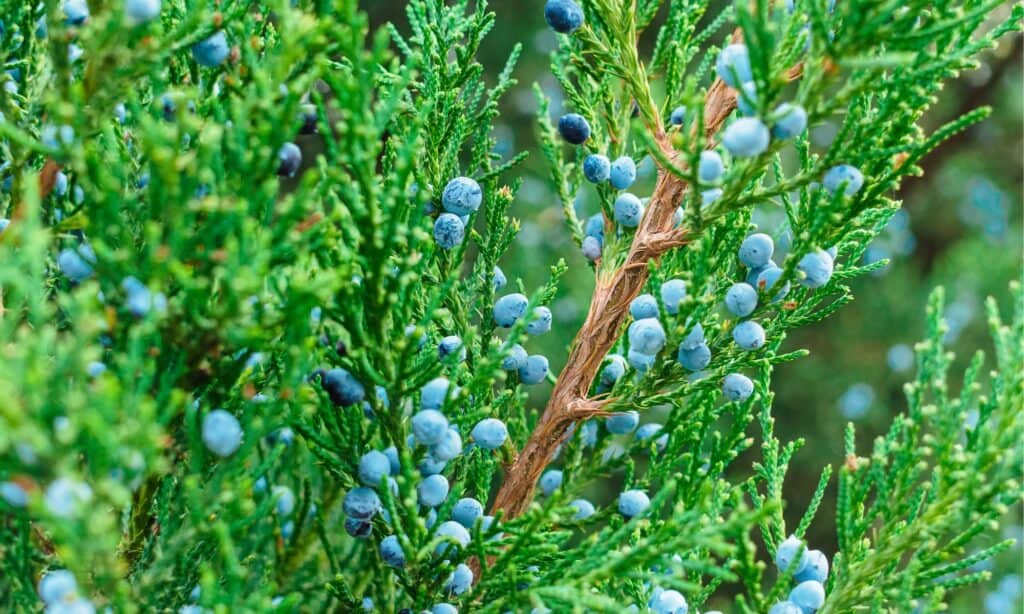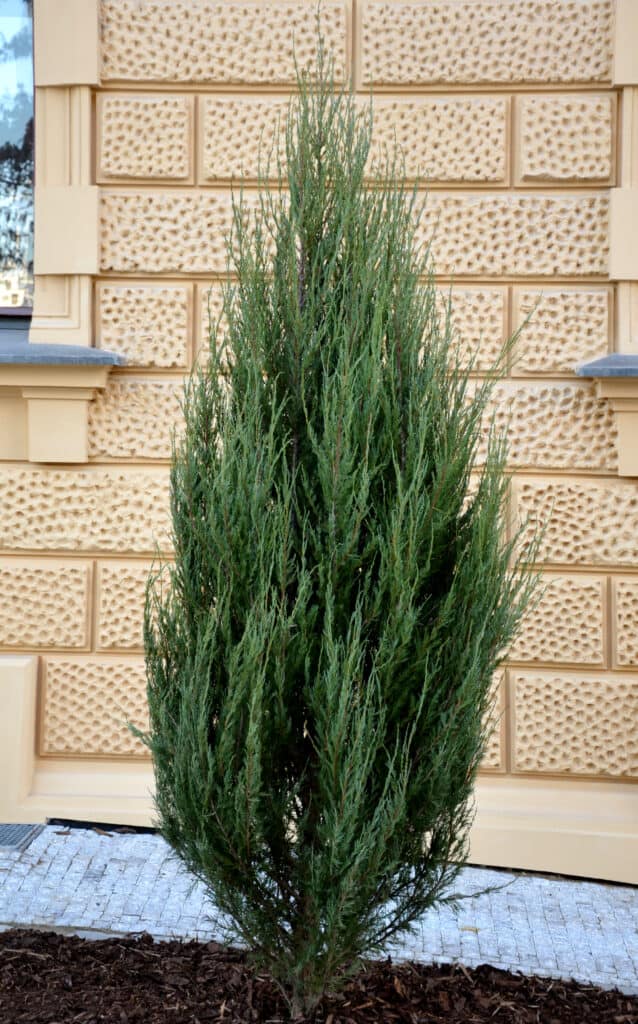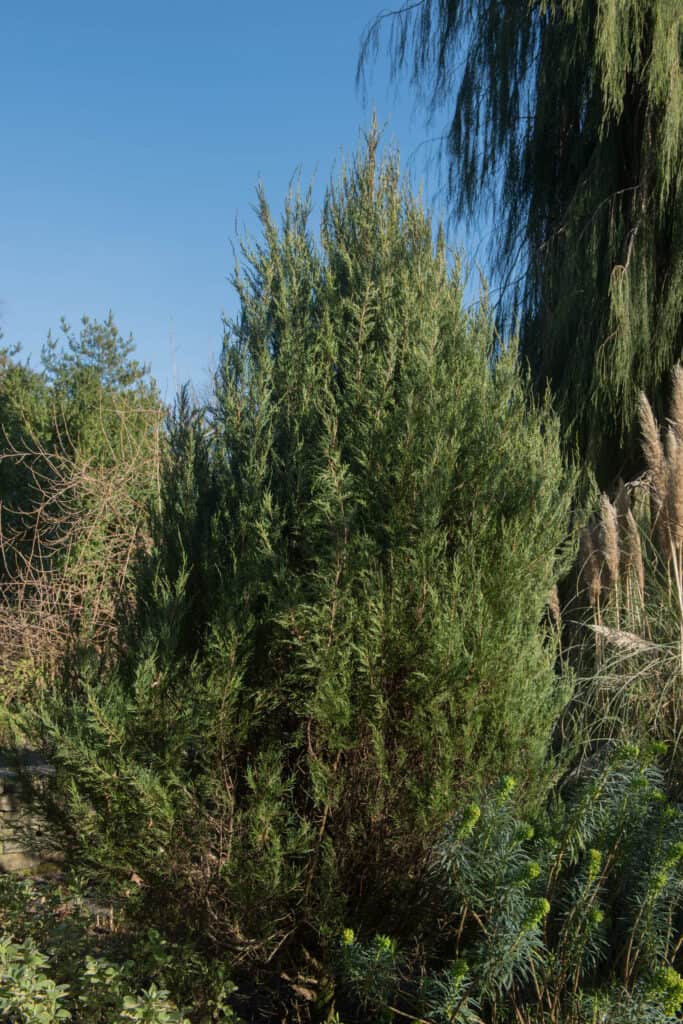Blue Arrow Juniper vs. Skyrocket Juniper are two very similar evergreen juniper trees that grow narrowly and upright, but are there any differences and which should you choose?
What Are the Differences Between Blue Arrow Juniper vs. Skyrocket Juniper?
The main difference between these juniper trees is the foliage color and their width. You may have guessed that Blue Arrow Juniper has a blue tone to its leaves whereas Skyrocket is silvery mid-green. Skyrocket is a wider tree too; its width is fatter than Blue Arrow by several feet. Blue Arrow won’t get wider than two feet, so it’s more of a pencil shape, whereas Skyrocket is shaped more like a pyramid.
What Are Junipers?

Juniper trees are conifers. They range from short shrubs to tall trees reaching 131 feet, but all 67 species are part of the Juniperus genus in the Cupressaceae family.
Junipers are native to the northern hemisphere stretching from Central America’s mountains all the way to the Arctic! They’re an extremely successful species of tree that grew on earth millions of years before the dinosaurs appeared. They continue to defy nature today growing at altitudes of 16,000 feet in Tibet! Experts conclude this is one of the highest places trees can survive.
Juniper Blue Arrow was a cultivar bred by botanists and Skyrocket was a natural mutation found in the wild, but both were selected to fit into the aesthetics of domestic gardens so they don’t get anywhere near as tall as 131 feet!
If you’re a plant killer, then junipers are a very good bet for your garden, just keep their roots relatively dry and they’ll take what life throws at them.
History of Junipers
Junipers grow in many parts of the world, so they’ve been used by a wide range of people for different tasks. Native Americans used junipers to make hunting bows and medicines. The Navajo eat juniper ash as an effective form of calcium. There are juniper wood remains helping archaeologists uncover sites in the Middle East that are thousands of years old.
Burning juniper foliage to cleanse the house of evil spirits is a rite associated with Europe, in particular, the Scottish and Irish communities of the United Kingdom. And coming right up to date, juniper oil is under research for its antimicrobial properties. It’s safe to say that juniper trees have helped humans for millennia!
Blue Arrow
Blue Arrow Juniper is also known as Blue Arrow Eastern Cedar. It was a seedling selection bred in Pennsylvania in the 1940s.
Skyrocket
Skyrocket Juniper is also known as Rocky Mountain Juniper Skyrocket. It was found in the wilds of Indiana and botanists think it was a natural mutation.
Blue Arrow Juniper vs. Skyrocket Juniper: Foliage

iStock.com/beekeepx
Foliage is the main difference between these two mountain conifers. Although they both have long soft needles on upright fastigiate branches they look very different.
Blue Arrow has matte blue needles which are slightly longer than the Skyrocket’s. Skyrocket’s foliage is silvery green and reflects more sun.
Both species have a waxy coat on their needles. This is to protect them from too much sunlight. If you grow your junipers in full sun, they will have less intense color than if you grow them in partial shade.
How Tall Are Juniper Blue Arrow and Skyrocket Juniper?

iStock.com/beekeepx
The second biggest difference is their spread and how quickly they reach full size. They differ, but the difference is not very much!
Blue Arrow reaches a maximum height of 20 feet tall and will spread to around two feet in width whereas Skyrocket reaches the same 20 feet in height, but it’s fatter at five feet wide.
Juniper Blue Arrow is the slowest of the two to reach its full height. It’ll take at least 20 years in perfect conditions, but Skyrocket rockets up and it can reach its full height after 15 years. In standard yards, the rate is slower, and Blue Arrow can even grow in a container for years before it needs to go into the ground.
However, this fast growth comes at a cost. In its rush to grow up, Skyrocket’s branches don’t harden off as much as Blue Arrow’s. They stay more flexible, so when the winter snows arrive, they can break off. Blue Arrow doesn’t have this problem because it hardens off its branches as it grows. That’s something to consider if you live in an area with lots of annual snowfall.
Growing Zones for Blue Arrow Juniper and Skyrocket Juniper
Blue Arrow Juniper and Skyrocket Juniper both grow in hardiness zones 4-9. It’s no surprise they can tolerate a wide range of conditions given their widespread native environments.
Any zones higher than 9 and junipers struggle to cope with the humidity that causes mold and rot in their dense foliage.
How to Grow Blue Arrow Juniper vs. Skyrocket Juniper

Blue Arrow Juniper vs Skyrocket Juniper are very easy to grow and suit even the most inexperienced gardeners.
Junipers grow best in very well-drained soil, so it’s important to make sure they don’t have consistently soggy roots. Sand or chalk is just fine but a swampy area won’t suit a juniper.
Dig a hole twice as wide as the root ball so the roots can spread out but don’t dig any deeper than the nursery pot. If the trunk is buried it will rot. If in doubt, let Blue Arrow or Skyrocket stand a little proud of the soil line. When you mulch, make sure no mulch touches the trunk for the same reason.
Water both junipers well until you can see new growth and keep watering them until they reach about four feet tall. Even though these trees are drought tolerant, newly planted young trees need lots of water to establish their roots.
Can You Propagate Juniper Trees?
Yes, it’s possible to propagate juniper trees and get baby trees for free!
Before you cut anything consider what month of the year it is, because there are two methods.
- Hardwood cuttings after mid-summer
- Softwood cuttings before mid-summer
A softwood cutting is taken from semi-ripe new season growth in spring:
- Choose a stem without any damage and cut it cleanly. It’s best to do this in the morning when the tree is full of moisture.
- Cut just above a bud, node, or leaf joint
- Remove the bottom half’s foliage and pinch off the soft tip
- Push it into gritty compost
- Cover in a clear plastic bag
- Put it on a warm windowsill
- Remove the bag for ten minutes a day to let in fresh air
After a few weeks, you will see new growth.
Hardwood cuttings are taken just after fall or in early spring from the current year’s (or previous year’s) growth. These stems will have hardened off, so they take longer to grow, often overwintering before showing any signs of growth.

iStock.com/pcturner71
Are Junipers Toxic To Dogs?
The ASPCA doesn’t list junipers as toxic to pets, but the effects are debated so it’s best to prevent dogs and cats chewing on juniper shrubs and trees.
Which Is Best: Blue Arrow Juniper vs. Skyrocket Juniper?
Blue Arrow has blue foliage whereas Skyrocket is silvery green, so if it’s down to color choice the best one is obvious!
Aside from their coloring, how quickly they grow and how wide they get are the main factors when you’re deciding between Blue Arrow and Skyrocket.
Skyrocket is the fastest of the two, so if you want a quick privacy tree it’s the best choice. Blue Arrow is slow growing but it’s half the width, making it more of a pencil shape which some landscapers prefer, especially those designing Japanese or Italian gardens.
One more thing. Remember that Skyrocket’s branches are more flexible than Blue Arrow and they can get damaged by heavy snowfall.
Up Next:
- Juniper vs. Cedar: 5 Key Differences
- Cypress vs. Juniper: What’s the Difference?
- Arborvitae vs. Juniper: What Are the Differences?
The post Blue Arrow Juniper vs. Skyrocket Juniper appeared first on AZ Animals.
from Animal News, Facts, Rankings, and More! - AZ Animals https://ift.tt/nABHJg2